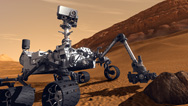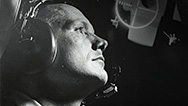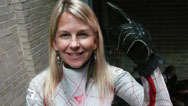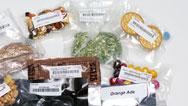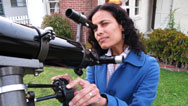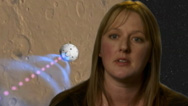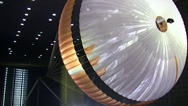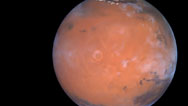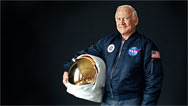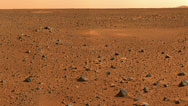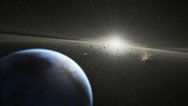
Can We Make It to Mars?
See new space suits, foods, and rockets that may support future Mars-bound astronauts, and meet a Mars rover driver. Aired August 1, 2012 at 10pm Aired August 1, 2012 at 10pm
- Originally aired 01.11.11

Program Description
Transcript
Can We Make It To Mars?
PBS Airdate: January 19, 2011
NEIL DEGRASSE TYSON (Astrophysicist, American Museum of Natural History)>: Hi, I'm Neil deGrasse Tyson, your host of NOVA scienceNOW, where this season we're asking six big questions.
On this episode, Can We Make It to Mars?
We would love to take a walk on the Red Planet, but can we get there alive?
JERRY LINENGER (NASA Astronaut, 1992–1998): You can go from a perfect day to a very bad day that quickly.
NEIL DEGRASSE TYSON: There's space rocks way faster than speeding bullets.
JERRY LINENGER: All of a sudden, I look and see the solar panel just joosh. Instant hole, this big.
SIGRID CLOSE (Researcher, Stanford University): This is why it's so dangerous to send out missions. They can take out a spacecraft.
NEIL DEGRASSE TYSON: And cosmic rays punching through our brains...
JERRY LINENGER: I would see a flash and flash, flash, flash.
NEIL DEGRASSE TYSON: ...and our selves.
C. MICHAEL FOALE (NASA Astronaut): They are a bullet traveling at an enormous speed.
NEIL DEGRASSE TYSON: Researchers are spinning up some ingenious plans...
JANNA KAPLAN (Researcher ,Brandeis University): Don't let the force leave you.
NEIL DEGRASSE TYSON: ...to keep astronauts safe, but will they work? And if astronauts do make it to Mars, what will they wear? Humans can't survive without a pressurized suit.
DAVA NEWMAN (Researcher, Massachusetts Institute of Technology): Basically, the gas in your lungs would boil.
DR. SMITH JOHNSTON (NASA Flight Surgeon): You would be dead very quickly.
NEIL DEGRASSE TYSON: NASA astronaut Mike Massimino...
MIKE MASSIMINO (NASA Astronaut): I feel like an Italian sausage.
NEIL DEGRASSE TYSON: ...looks into a revolutionary new idea to keep Mars explorers alive and kicking.
Also, would you eat a piece of meat that's been sitting around for eight years? I did!
This NASA lab is cooking up food for the long journey to Mars. Eating in space is already no picnic, but with or without gravity, some of the space meals are delicious.
Mmm, I like that.
But can they stay tasty all the way to Mars?
Now this looks nasty.
MICHELE PERCHONOK (NASA Food Scientist): That is.
NEIL DEGRASSE TYSON: All that and more, on this episode of NOVA scienceNOW.
Four decades ago, humans first walked on the moon, satisfying our thirst for exploration. And now we're setting our sights on another rock out there: Mars.
A trip to the Red Planet would likely cover a half a billion miles, about a thousand times farther than the Apollo missions. A roundtrip could take two or three years, and one big challenge is surviving harsh conditions, including some we don't encounter here on Earth.
Here in the New Mexico desert, home to of all sorts of top-secret government projects, NASA has built one of the world's most powerful guns. Some 60 yards long, it targets spaceships, though not alien spaceships, our own.
The gun simulates cosmic collisions that will threaten astronauts traveling to Mars.
So, you guys call this a gun? But it looks nothing like a gun. I think of a gun, I think of handguns or rifles. How fast does a rifle bullet go?
DONALD HENDERSON (White Sands Test Facility): About 2,000 miles per hour.
NEIL DEGRASSE TYSON: And what do you pull out of this?
DONALD HENDERSON: Twenty-thousand miles per hour.
NEIL DEGRASSE TYSON: Twenty thousand miles an hour? That's fast.
The most surprising thing is not the gun's size or power, but its bullets.
These itty bitty things?
DONALD HENDERSON: Uh huh.
NEIL DEGRASSE TYSON: Twenty thousand miles an hour?
They represent a danger that could end a mission to Mars. Space is not as empty as you might think, but littered with small fragments of comets, asteroids and planets, called meteoroids. In the vacuum of space, they move at deadly speeds.
And NASA's huge gun demonstrates just how dangerous they can be. These metal plates represent the walls of an unshielded spacecraft.
DONALD HENDERSON: This is a half-inch projectile, and it was traveling at about 16,000 miles per hour. It made a hole in the front plate, and then a slightly larger hole.
NEIL DEGRASSE TYSON: It kept going?
DONALD HENDERSON: Yes.
So an astronaut could be right behind this wall.
And this...
NEIL DEGRASSE TYSON: Whoa.
DONALD HENDERSON: ...is what is left over. It is essentially...
NEIL DEGRASSE TYSON: Whoa.
DONALD HENDERSON: ...a shotgun blast.
NEIL DEGRASSE TYSON: The speed of the impact shattered the bullet, and its debris smashed ever-larger holes in the inner walls. It's a sobering lesson for NASA.
Meteoroids have already knocked out or damaged numerous spacecraft, including the probe Mariner 4, which snapped the first close-up pictures of Mars in 1965.
After its fly-by...
SIGRID CLOSE: It ran into a cloud of meteoroids no bigger than the size of a grain of sand. And over the course of about 45 minutes, they were seeing thousands of impacts on the spacecraft.
NEIL DEGRASSE TYSON: Another meteoroid strike was witnessed by astronaut Jerry Linenger.
JERRY LINENGER: During my time on the Russian Space Station, all of a sudden, I look, in the corner of my eye, I see the solar panel just joosh, you know. Instant hole, this big.
NEIL DEGRASSE TYSON: If astronauts are to survive a mission to Mars, we have to find a way to protect them from meteoroids. And so, today, the gun will test new lightweight shielding for the walls of a Mars spaceship.
It doesn't look very protective. This is foam I can stick my finger in.
DONALD HENDERSON: But it's a smartly designed shield, because what happens is the velocity is so fast—of these projectiles—when they impact, the speed breaks it apart, and then the rest of this target will absorb the impact.
NEIL DEGRASSE TYSON: So will this shield stop a projectile going over 16,000 miles an hour?
To find out, the shield is bolted in the target chamber. Then air is pumped out, to replicate the vacuum of space. We head to the bunker below for protection while the gun gets fired.
CONTROLLER(NASA): Three, two, one.
NEIL DEGRASSE TYSON: That was cool.
And the result? Did the shield stop the bullet?
Well, obviously it went through.
CONTROLLER: Yup.
NEIL DEGRASSE TYSON: But just look at the inner wall:no penetration. Nothing came out the other side.
CONTROLLER: That's right, it worked.
NEIL DEGRASSE TYSON: The layers of foam, metal and bulletproof materials pulverized the debris from the impact.
So this takes out all the energy of those projectiles.
DONALD HENDERSON: And it stops them.
NEIL DEGRASSE TYSON: So this is where astronauts can be? They can be cooking breakfast here. They're safe from the hazards of space.
Well, not really. Meteoroids are only one peril of many.
JERRY LINENGER: Systems failing, possibility of a fire, possibility of losing electrical power—you can go from a perfect day to a very bad day that quickly.
NEIL DEGRASSE TYSON: Some threats aren't so obvious. In fact, one of the biggest looks like harmless fun.
Many astronauts report that being weightless is what they love most about space.
CLAYTON ANDERSON (NASA Astronaut, 1992–1998): I would wake up in the morning and fly to breakfast; then I would fly to work. I could fly to the bathroom, and I even flew while I was going to the bathroom. I was Superman every single day.
NEIL DEGRASSE TYSON: But what feels good may not be so good for you, as Jerry Linenger discovered after spending five months in zero gravity on the Russian Space Station.
JERRY LINENGER: By the time I got back, I had about a 14 percent bone loss. Now that was isolated to hips, lower spine. And my strength level was probably 65 percent of what I went up there with.
NEIL DEGRASSE TYSON: With no gravitational force to work against, your body not only doesn't need the same amount of muscle and bone, it starts breaking them down. As on Earth, so in space: use it or lose it. And exercise may not solve the problem.
JERRY LINENGER: I exercised two one-hour periods every day, religiously. And my personal experience is that the bone loss seems to keep going on and on.
NEIL DEGRASSE TYSON: And yet, there is a solution: artificial gravity, a force created by spinning.
You can see it in the sci-fi classic, 2001: A Space Odyssey. And you can experience it right now, in this small, spinning room at Brandeis University, as I did, recently, with neurophysiologist Janna Kaplan.
JANNA KAPLAN: Notice how we talk to each other, but we don't look at each other.
NEIL DEGRASSE TYSON: Yes, well, I want to look at you, but I feel...
JANNA KAPLAN: Don't!
NEIL DEGRASSE TYSON: It's hard.
I'm trying to conduct a conversation, but I'm having trouble turning my head.
The rotation, you see, is generating a centrifugal force that pushes everything in the room away from its center, towards the wall. It makes me lean pretty oddly, but, far as my body is concerned, this force is no different from gravity. To move, I have to work against it.
Okay, now I've got to turn around.
JANNA KAPLAN: Now, turn around slowly. Try to peel off the wall.
NEIL DEGRASSE TYSON: And I mean work.
JANNA KAPLAN: Peel. Everything is a peeling motion.
NEIL DEGRASSE TYSON: No chance of muscles and bones wasting away around here.
JAMES LACKNER (Brandeis University): It's the centrifugal force which is pushing him backwards. So, he feels like he's got to fight so hard to get away from the wall. And he may feel as much as 30 percent heavier.
JANNA KAPLAN: Always feel the force.
NEIL DEGRASSE TYSON: May the force be with me.
JANNA KAPLAN: Don't let the force leave you.
NEIL DEGRASSE TYSON: Now remember, this room is on Earth. So, spinning or not, our planet's own gravity is always pulling us downward. Meanwhile the artificial gravity pushes us backwards. The two forces combined make things hang in here at odd angles. And this is also why the room eventually makes some visitors a bit queasy.
But if I were free of real gravity, artificial gravity would have me jogging comfortably on the wall, just like they did in 2001.
Now, building a spinning spaceship isn't practical. But a small spinning room on board might suffice, giving astronauts an Earth-like exercise space to keep their bones and muscles from wasting away.
Though that's not to say Mars explorers will be safe—even remotely, because they'll still have to face the worst space danger of all, a danger astronauts see, simply by closing their eyes.
JERRY LINENGER: I used to sleep upside down, piece of Velcro around me. Close my eyes, and then I would see a flash and flash, flash, flash.
MICHAEL FOALE: You'd get this single point of light and then a big circle around it, right there in your brain.
NEIL DEGRASSE TYSON: The flashes are caused by cosmic rays, subatomic particles, like protons, generated by exploding stars, far off in our galaxy. Traveling close to light-speed, these high-energy particles will pierce a spaceship and its astronauts, their retinas, their brains.
This doesn't happen on Earth, because our planet's atmosphere and magnetic field protect us from the constant barrage of cosmic radiation.
JERRY LINENGER: You go to Mars, you're going to get a very heavy radiation dose. There is no way to protect against that. You can't carry lead up into space in a wall that would be thick enough.
MICHAEL FOALE: There is not much to stop them because they are so energetic. They are a bullet traveling at an enormous speed.
NEIL DEGRASSE TYSON: Pelted by this highly destructive kind of radiation, D.N.A. breaks apart, predisposing the cell to cancer.
Research continues, but we have yet to find a practical defense against cosmic rays.
JERRY LINENGER: You go to Mars, you're raising your risk of cancer, lifelong. But there are always innate risks to space travel, and there's no way to get around them. And you just do your best to minimize those risks and control them where you can.
NEIL DEGRASSE TYSON: So we might be able to protect our Mars explorers from some of the dangers they will face, but only some. Yet, knowing all that, today's astronauts are undeterred.
PEGGY WHITSON (NASA Astronaut): In my mind, it's part of our genetic code that we should explore to see what's beyond the mountain. And I would love to be the first person to step on another planet.
ANDREW THOMAS (NASA Astronaut): Just imagine what that would be like. Everything you see would be completely alien to your experiences here on Earth. It would be just an amazing, amazing experience.
MICHAEL FOALE: I would go to Mars under any condition. I would dearly, dearly like to take my wife with me. Human evolution involves exploration.
JERRY LINENGER: And I don't care what the risk is. That's something, that you actually are moving mankind forward. It is worth your life, and I'd sign up for that mission in a heartbeat.
Meet the "water bear."
They're very small.
They can survive temperatures as low as -459°F.
>And as high as 257°F.
They can go without water and air for at least 10 days.
And many are able to survive radiation exposure.
It's the only animal that can survive the harsh conditions of space.
Sign them up, NASA.
NEIL DEGRASSE TYSON: One thing obviously lacking in space is air. Now, of course, air is crucial for us to stay alive. Our bodies need a constant supply of oxygen.
Here on Earth, air provides something just as essential but much less obvious: pressure.
Consider this: a column of air one inch across, stretching from the ground to the top of Earth's atmosphere, weighs about 15 pounds. That's about the same weight as a small dog, or a watermelon. We don't feel it, but that weight is constantly pressing against our bodies and within our lungs. Without it, we'd be dead.
NASA astronaut Mike Massimino has survived the deadly vacuum of space. We got him to tell us how and what we need to do before humans can safely walk on Mars.
MIKE MASSIMINO: Astronauts like me might not like to admit it, but space is a dangerous place. I've walked in space four times. That's me doing repairs on the Hubble Space Telescope. Every minute I'm out there, I know the only thing between me and oblivion is my spacesuit.
The first step, getting dressed for space, is to put on some undergarments. So now I have on my T.C.U., or thermal comfort undergarment, which is the slang for long underwear. And underneath that is my M.A.G., or the maximum absorbency garment, which is slang for diaper. And that answers the question of "how do you go to the restroom if you're locked inside of the spacesuit?"
At roughly 10,000,000 dollars, today's spacesuit is one of the most expensive garments in the entire solar system. And a lot of that expense goes into creating something you wouldn't expect: air pressure.
SABRINA GILMORE (NASA Spacesuit Instructor): Because the astronauts have to take their own pressure when they're doing their spacewalk, you can think of the spacesuit as, like, a big bag of air.
MIKE MASSIMINO: So why is air pressure so important? What would happen to our bodies without it?
SMITH JOHNSTON: If somebody gets sucked out of the space station without a spacesuit, what would happen? Well, that would be a very bad day.
You would not explode; you would just slowly expand. And you'd get to a certain spot, and then, essentially, turn to a goo, a mush, and then sort of vaporize. You would be dead very quickly.
DAVA NEWMAN: Basically, the gas in your lungs and even the solution in your bloodstream would boil.
MIKE MASSIMINO: The cells in your body are filled with dissolved gases, like oxygen and nitrogen. Without air pressure pushing hard against these cells, all that gas is going to bubble out of solution, just like it does when you open a bottle of soda.
DAVA NEWMAN: We cannot survive, just the human body, in the vacuum of space. We have to have protection from a spacesuit.
MIKE MASSIMINO: But how much air pressure does the spacesuit need to keep us alive?
Down here on Earth, the one atmosphere of air pressure at sea level feels very comfortable. As you rise up in altitude, there are fewer air molecules around you, producing less pressure. At 30,000 feet, the height of Mt. Everest, the pressure drops to only one-third of an atmosphere. Luckily, as long as there's plenty of oxygen, humans can survive okay in one-third atmosphere, and that's the amount of pressure they put into the spacesuit.
The whole spacesuit is pumped full of air, like a balloon. But even that causes a major problem. It makes the suit incredibly stiff.
SABRINA GILMORE: You can think of it as like a football. When a football's not inflated, you could bend it a little bit. But, when it's pressurized you would not be able to bend it. And the spacesuit's not that different.
MIKE MASSIMINO: And all that stiffness makes the suit extremely hard to move around in.
In space, I use up a lot of my energy just fighting the suit. The stiffness is particularly noticeable in the gloves. The pressure that keeps me alive makes it really difficult to use my hands.
SABRINA GILMORE: If you took a rubber band and wrapped it around your fingers, and if you just opened and closed maybe 15, 20 times, you'll get a feeling of what makes it so physically demanding.
MIKE MASSIMINO: Astronauts have been on the front lines of the battle between life-saving pressure and mobility since the beginning of space travel.
By the time Neil Armstrong made that giant leap for mankind it was clear: leaping was doable, walking, not so much.
Trust me. I know. These suits aren't made for walking.
If we want to send human explorers to Mars, we're going to need a new kind of spacesuit.
SMITH JOHNSTON: We have to have much more robust suits and capabilities, before we can even think about going to Mars.
MIKE MASSIMINO: Back down on Earth, at my alma mater, M.I.T., a former classmate, Dava Newman, has set up a space-age garment district. She's trying to create a new spacesuit, specifically designed for Mars. Her biggest challenge? Perfecting a whole new way of producing lifesaving pressure.
DAVA NEWMAN: My passion is astronaut performance. Is there a different way, a better way, perhaps, to provide pressure?
MIKE MASSIMINO: And the solution? Dava wants to shrink-wrap astronauts and apply the pressure directly to their skin.
Hollywood has been shrink-wrapping space-traveling actresses for years, but the goal was purely aesthetic. No one knew if you could build enough pressure into a tight suit to keep an astronaut alive, so Dava does a lot of experimenting.
DAVA NEWMAN: Let's roll up your pant leg.
MIKE MASSIMINO: Alright.
DAVA NEWMAN: We're going to show you a prototype of mechanical counter-pressure, meaning where we apply the pressure directly to your skin. We really want you to have maximum mobility, just like you would in your street clothes.
MIKE MASSIMINO: Yeah.
DAVA NEWMAN: So, I'm going to put this suit completely on you, like "shrink-wrap an astronaut."
We need to provide a third of an atmosphere, and we've been working on that for about 10 years. Could we provide enough pressure to keep someone alive?
MIKE MASSIMINO: One way to find out is to wrap body parts in super stretchy material to see if you can apply pressure uniformly, otherwise it could hurt.
I feel like an Italian sausage. That's what I feel like.
Wrapping people like sausages is just the beginning. Dava studies human motion, trying to preserve mobility while maintaining pressure. She even tries out her spacesuit ideas on a robot.
DAVA NEWMAN: I'm collecting a lot of data out of the robot because it informs our spacesuit design.
MIKE MASSIMINO: But even the tightest girdle-like bodysuit can't provide quite enough pressure to keep a person alive in the vacuum of space.
It just isn't tight enough.
DAVA NEWMAN: If we put the astronauts into a compression stocking, that's great. But it still only gets me two-thirds of the way there.
How can I get the rest?
MIKE MASSIMINO: Looking for inspiration to solve the problem, Dava turns to the animal kingdom. The possibilities are endless: the balletic bat, the slithery snake, or the creature with the highest stature in the animal kingdom: the giraffe?
DAVA NEWMAN: I always wondered, "Why don't giraffes faint?" That's a tall creature. His head's down eating on the grass, puts his head up to reach the tree, five meters. Why doesn't he faint?
MIKE MASSIMINO: So what about the giraffe's physiology keeps its blood from rushing out of his head?
DAVA NEWMAN: I actually think giraffes have, like, an internal g-suit, an instantaneous pressurization.
MIKE MASSIMINO: Special muscles in the giraffe's blood vessels constrict to create pressure. That blocks the blood from escaping out of his head.
DAVA NEWMAN: Maybe we can learn from nature—biomimicry—and, as an engineer, put that into some of our designs.
MIKE MASSIMINO: The constricting vessels in the giraffe's upper neck inspired the idea of building additional pressure into the suit with a tight web of super-strong red fibers.
DAVA NEWMAN: Now, what I'm doing is giving you a bit of structure. Through that structure, I can actually even carry more pressure.
MIKE MASSIMINO: So if you just had the complete suit here, without the lines, you'd be able to move around in it fine, but you wouldn't get the pressure, the protection you need to work in the vacuum of space.
But the red lines need to go in just the right places, so they don't inhibit mobility.
Though we don't have a complete, full-pressure suit yet, we're getting there, and Dava's built a slightly looser mockup. This could be the spacesuit of the future.
I can't wait to see what she looks like.
She calls it the biosuit.
You look like a superhero!
DAVA NEWMAN: I want to be Elastigirl. Yeah, Elastigirl was one of my favorites.
MIKE MASSIMINO: You look like Elastigirl. It's futuristic.
Amazingly, a combination of tight stretchy fabric and a stiff web of fibers looks like it can provide the necessary pressure directly to the skin, but it isn't easy.
What is the hardest part of the body to pressurize in this suit?
DAVA NEWMAN: It's definitely the elbows, the joints, and the concave areas: the back of the knees, armpits. Those areas are really complicated.
MIKE MASSIMINO: I volunteered to test-drive her suit in space. Unfortunately, the mockup isn't mission-ready, and it only comes in ladies sizes.
When are you going to be ready for primetime?
DAVA NEWMAN: We would really need a few more years of research, so that's where we're at in terms of the development of the suit.
MIKE MASSIMINO: A fully functional biosuit will contain smart wires so scientists can monitor your vital signs. The hard backplate will support the oxygen tanks needed for breathing.
Speaking of breathing, that part of the suit would be pretty much the same as today, with a gas-pressurized helmet, but you'll breathe easier.
Dava's found you could run around in the biosuit and consume about 50 percent less oxygen than you would in today's bulky suit.
DAVA NEWMAN: We've proven the technical feasibility. This is possible. We might have this incredibly different way to design spacesuits for the future.
MIKE MASSIMINO: I may be too old to go to the Red Planet, but it's almost certain that the astronauts of tomorrow will have a very different wardrobe than the one I've been wearing. They'll have suits that are made for walking.
NEIL DEGRASSE TYSON: Even after just a few days in the fridge, a lot of food can get pretty unappetizing, mostly because mold and bacteria begin to take over your food. So, imagine eating meals that had been sitting around for two to three years!
That's what the astronauts who go to Mars are going to have to do.
I met some chefs trying to cook up delicious dishes that will provide all the comforts of home, even when the dining room is 100 million miles away. In a food lab at the Johnson Space Center, Michele Perchonok heats up pork chops for a taste test.
If you're the type who likes your food fresh, this isn't the meal for you. One of these chops has been sitting on a shelf at room temperature for two years, the other has been lying around for eight. That's right , I said "eight" years.
Can I tell which one? And will my stomach mind this experience less than it did artificial gravity? We shall soon find out.
I think this one is older.
So, in other words, it wasn't obvious to me that one was eight years old and one was two. But I have to...if I were to guess, I would say this one, because the meat was just a little mushier, and I'm thinking maybe it would break down over time.
MICHELE PERCHONOK (NASA Food Scientist): Actually, that one's the two-year-old product, and this one's the eight-year-old product.
NEIL DEGRASSE TYSON: So, I was wrong?
MICHELE PERCHONOK: You were wrong.
NEIL DEGRASSE TYSON: Michele heads up a team figuring out how to feed astronauts all the way to Mars and back. The food will have to be nutritious, last for years, taste good and, of course, behave itself in zero gravity.
You see, weightless food tends to do the darndest things, which limits the menu.
SUNITA WILLIAMS (NASA Astronaut): Anything that can just float in the air easily is a problem. And it's going to get in people's sleeping bags, it's going to get in science experiments, it's going to get in people's eyes. One of the reasons I cut my hair when I was up there was I was worried about people at the dinner table eating and then a piece of my hair comes by and floats in their mouth.
NEIL DEGRASSE TYSON: Astronauts cook by adding cold or hot water to freeze-dried foods, or heating food pouches in an electric warmer. A pair of scissors—in space more useful than a fork or spoon—opens the meals, which, actually, can be pretty good, as I discover courtesy of Vickie Kloeris, Michele's colleague.
What's next?
VICKIE KLOERIS (NASA Food Scientist): Okay, We have one of our thermal-stabilized entrees, fiesta chicken.
NEIL DEGRASSE TYSON: Thermal-stabilized? Again, it's just preserved?
VICKIE KLOERIS: Preserved, shelf-stable.
NEIL DEGRASSE TYSON: Preserved is a little more appetizing than thermal-stabilized. Put simply, it's a way of killing germs with heat.
And I see, uh, Cyrillic characters here? In Russian?
VICKIE KLOERIS: Well, actually in Russian it translates as "party chicken."
NEIL DEGRASSE TYSON: Party chicken!
VICKIE KLOERIS: Which was a little difficult for our Russian colleagues to understand.
NEIL DEGRASSE TYSON: And I'll taste this.
Mm, I like that.
MICHELE PERCHONOK: That's a very good product.
NEIL DEGRASSE TYSON: Good for Earth orbit, but what about Mars? When it comes to feeding an expedition like that, problems multiply.
Michele and Vickie must plan 7,000 meals and snacks to nourish six people for up to three years. And if food is sent ahead of the astronauts, it will have to keep for five years. Yet only seven of NASA's 65 thermo-stabilized edibles have that kind of shelf-life. The rest end up like this.
So, this looks nasty.
MICHELE PERCHONOK: That is very nasty. So what you are looking at here is our citrus fruit salad, five-year-old versus two-year-old.
NEIL DEGRASSE TYSON: So something happened between two and five years. What?
MICHELE PERCHONOK: There's a lot of chemistry going on.
NEIL DEGRASSE TYSON: Even if you kill off every microbe in sealed food, it still contains sugars and proteins that react with each other over time. The result is obvious when you compare this youthful and geriatric chicken salad.
So the chicken gets darker and the greenery becomes pale, and it's not just a cosmetic phenomena.
MICHELE PERCHONOK: No.
NEIL DEGRASSE TYSON: You are losing nutrients, you're losing...?
MICHELE PERCHONOK: You are losing flavor, nutrients, probably texture, you're losing everything.
NEIL
DEGRASSE TYSON: A solution might be
new packaging that keeps out all water and air, unlike today's plastics.
MICHELE PERCHONOK: With that packaging, we get a about a 9- to 12-month shelf-life. So there is no way we are going to Mars with this kind of packaging.
NEIL DEGRASSE TYSON: Nor can we use foil, fine for low-earth orbit, but too heavy for Mars, when you're launching 22,000 pounds of food at the cost of a million dollars per pound.
There is also something else to consider.
JERRY LINENGER: When you're in space, stuck inside, basically, a can, food becomes, kind of, a highlight of the day.
CLAYTON ANDERSON: You have to eat in order to survive, but what people don't understand, I don't think, is the psychological aspect of food.
ANDREW THOMAS: Because it is one the few pleasures that you have control over. And I think people serving on submarines have long understood the importance of food for crews' well-being.
NEIL DEGRASSE TYSON: Since good food makes astronauts happy, I asked Michele and Vickie if there's a popular dish they'd especially like to send to Mars.
VICKIE KLOERIS: Well, I think that would be our shrimp cocktail.
NEIL DEGRASSE TYSON: That sounds good.
VICKIE KLOERIS: Our shrimp cocktail is a freeze-dried product. So this has been rehydrated.
NEIL DEGRASSE TYSON: It's not only the shrimp, it's the cocktail sauce?
VICKIE KLOERIS: It's the sauce.
NEIL DEGRASSE TYSON: If Earth were 50-million miles away, this would be five stars, but on Earth I've had better shrimp cocktail at the local...
VICKIE KLOERIS: I certainly hope so.
NEIL DEGRASSE TYSON: It better not have been freeze-dried for what I was paying for it.
Everyone loves soda pop!
It tickles your tummy!
And makes you burp!
But never drink soda pop in zero gravity...
Because everything you eat and drink just floats around in there...
So when you burp, it isn't just air that comes out!
Sorry.
That's why astronauts don't bring soda pop to space.
NEIL DEGRASSE TYSON: If you have to cross a great distance with no pit stops, the slower you go, the more supplies you're forced to carry. And if your route takes you through dangerous territory, all the more reason to speed things up.
That's especially true for a roundtrip to Mars, which, with current technology, might take two or three years.
Correspondent Jake Ward caught up with some folks trying to revolutionize space flight. And if their plans work, future spaceships would go so fast, they'd leave our long-distance-traveling woes far behind us.
JAKE WARD (Correspondent): The space between Earth and Mars is filled with stuff that can kill you: meteoroids can smash your spaceship to bits; zero gravity eats away at your bones; and cosmic rays increase your odds of getting cancer. The risks all get worse the longer the trip. Right now, the best rockets would take two and a half years to get us there and back.
MICHAEL FOALE: Two and a half years is what I see as the biggest risk going to Mars.
JAKE WARD: Why so long? The problem is fuel.
The fuel in this shuttle tank weighs almost a million pounds, and that just gets you into near-earth orbit. Mars is still more than 35,000,000 miles away. You can't carry enough fuel to fire engines all the way to Mars. In fact, a chemical rocket would empty its gas tank just escaping Earth's gravity and then would let momentum carry it the rest of the way.
EDGAR BERING (Astrophysicist, University of Houston): Now, the problem with that is that you're coasting the whole way.
JAKE WARD: Which takes a very long time.
EDGAR BERING: The other problem with that is that if anything goes wrong, you're stuck. You have no abort capability in mid-flight.
JAKE WARD: Former astronaut Franklin Chang-Diaz is well aware of the dangers of such a mission.
FRANKLIN CHANG-DIAZ (Astrophysicist, Ad Astra Rocket Company): At that point, you have no choice but just to continue to go. And, god forbid, you lose propellant or you lose an oxygen tank, and it's not going to be possible to return. And we would watch this crew die, for months, in front of the whole world.
JAKE WARD: To make sure this doesn't happen, engineers are designing new kinds of rockets that could go much faster and more efficiently. They range from water vapor thrusters to going nuclear, but none can get a crew to Mars and back in less than a year.
So, this is it.
FRANKLIN CHANG-DIAZ: This is it.
JAKE WARD: But here, outside Houston, Chang-Diaz and his team are building a potentially game changing rocket called the VASIMR.
FRANKLIN CHANG-DIAZ: The ultimate goal is to have a small sun in the engine.
JAKE WARD: A sun in the engine? Well, kind of. The VASIMR uses radio waves to heat argon gas to a million degrees, so hot it becomes a plasma. The sun is made of plasma. In a plasma, atoms break down into a soup of charged particles that move very, very fast. And if you fire these very hot, very fast particles out the back of a spaceship, you've got a rocket that can really move.
But putting this sun in the engine creates some new problems.
Think of this candle as a conventional rocket. It's plenty hot, but VASIMR, it's really a whole other ball of wax.
Test firings have already topped a million degrees, thousands of times hotter than a chemical engine.
So the challenge for VASIMR is: how do you keep an engine this hot from destroying everything around it?
LAWRENCE DEAN (Ad Astra Rocket Company) This is 3/16 stainless, and it was in the way of the plume coming out.
JAKE WARD: Wow!
LAWRENCE DEAN : It did a pretty good job on it.
JAKE WARD: I don't know much, but this is broken. I know that much. Holy cow.
Fortunately, there may be a solution: magnets. If you can encircle the million-degree plasma with a strong magnetic field, it will form a heat shield and stop the plasma from destroying its surroundings.
With this shield in place, Franklin thinks the VASIMR can go 35 miles per second, through space. That's fast enough to get from New York to Los Angeles in roughly a minute and a half.
That means you could cut down the roundtrip to Mars from two and a half years in a chemical rocket, to just five months. And by getting about 5,000 miles to the gallon, you'd be lugging around a much smaller gas tank.
In 2014, they plan to test the VASIMR engine in space, for the first time, when they attach it to the International Space Station. After that, they hope to get it ready for deep space travel. And if it's successful...
FRANKLIN CHANG-DIAZ: It completely opens up not just a mission to Mars, but it opens up, potentially, the entire solar system to human exploration.
Don't like the high cost of rocket fuel?
Tired of racing around in space?
Wouldn't it just be great to slow down and enjoy the ride?
Yes. One day we might just be sailing through space!
Light from the sun actually pushes against reflective surfaces.
And if they are large enough, they can propel a vessel through space.
And scientists have already launched some successful tests.
So how long would it take to get to Mars?
A little over two years!
NEIL DEGRASSE TYSON: It might take a while before we have the technology to get a human safely to Mars, but, in the meantime, we're already exploring the Red Planet.
So, what's it like on Mars?
ROBOT: What's it like? It's freezing, that's what. And the dust!
NEIL DEGRASSE TYSON: Alright, move five meters to the right, and pick up that rock.
ROBOT: That's easy for you to say. You know what dust can do to your servos?
NEIL DEGRASSE TYSON: Oh, come on. Give it a try!
ROBOT: Give it a try? I don't believe this guy.
NEIL DEGRASSE TYSON: Okay, so today's Martian robot explorers don't have this much attitude. But in this episode's profile, we meet a designer who thinks maybe they should.
Vandi Verma is a natural born trailblazer.
VANDI VERMA (Mars Rover Driver): I really love adventure and exploration.
NEIL DEGRASSE TYSON: She constantly looks for new discoveries to make and obstacles to overcome, from climbing mountains to flying planes to her job as a rover driver at NASA.
VANDI VERMA: I've always loved exploring the environment I was in, and the rovers allow me to explore another planet.
NEIL DEGRASSE TYSON: Humans may be decades away from visiting Mars, but Vandi gets a first-hand look at the Red Planet every day she goes to work.
PAUL TOMPKINS (Space Robotics Engineer/Vandi Verma's Husband): Through being at that console, she gets direct virtual presence on the surface of Mars in a way very few other people in the world do.
NEIL DEGRASSE TYSON: She is one of the people responsible for making sure the rovers, Spirit and Opportunity, make it through each drive safely.
NASA originally scheduled the mission to last just 90 days, but that was back in 2004, and the vigilance of drivers like Vandi has kept the rovers alive and exploring much longer.
Vandi began dreaming of this interplanetary adventure back in 1997, when NASA sent another rover, Sojourner, to Mars.
VANDI VERMA: So, when the very first Mars rover landed, I remember reading about it, and I was just amazed because it was such an amazing thing to do, to accomplish, to get a rover on another planet. And I was like, "Someday, I want to work on that."
NEIL DEGRASSE TYSON: Her passion for out-of-this-world exploration traces back to her childhood in India.
VANDI VERMA: I first became interested when somebody gave me this little book about space. And it was the first time I realized just how vast the universe was, and just how different the various planets, even in our own solar system was. And I wanted to see them. It seemed like a very remote possibility, but I never gave up hope for it.
NEIL DEGRASSE TYSON: The odds were stacked against her. Growing up in a traditional Indian family, Vandi was expected to follow her mother's wishes, to settle down and enter an arranged marriage with a nice Indian husband.
VANDI VERMA: My parents have an arranged marriage. My sister has an arranged marriage. For whatever reason, it wasn't something that I was ready for.
NEIL DEGRASSE TYSON: Vandi dreamed of following a different path, inspired by her father, an air force pilot. Unlike her cautious mother, her dad encouraged her to take risks and seek adventure.
After high school, she took her first big step. She moved to the United States and studied engineering at Carnegie Mellon University. But that didn't stop Vandi's mother from trying to arrange a marriage for her.
VANDI VERMA: She would find people in Pittsburgh, when I lived there. I was amazed. And they would call me.
NEIL DEGRASSE TYSON: Vandi dodged her mom's suitors long enough to meet classmate, and fellow roboticist, Paul Tompkins.
PAUL TOMPKINS: Like Vandi, I've been in love with space for as long as I can remember.
NEIL DEGRASSE TYSON: In 2005, they decided to spend their lives together.
VANDI VERMA: We both love adventure.
NEIL DEGRASSE TYSON: They share a love for taking risks but not chances.
VANDI VERMA: It's very natural for me to take risk. At the same time, it's calculated risk.
PAUL TOMPKINS: So, she has the element of adventure on one side, but then she's smart about it, because she's not going to take a foolhardy risk.
NEIL DEGRASSE TYSON: She realized that this calculated risk mindset would also help navigate her new field.
VANDI VERMA: I discovered robotics when I was at Carnegie Mellon, and, instantly, I knew this was what I wanted to do. Robots are incredible for exploring space or any areas where it's hard to send humans, because we don't have to worry about survival, you know, food and water.
NEIL DEGRASSE TYSON: While getting her Ph.D., Vandi headed to the Atacama Desert in Chile, to hone her robot-driving skills in its Mars-like terrain.
VANDI VERMA: Atacama is a place where they measure rainfall in millimeters per decade. And that was a perfect place for us to take our robot and do an astrobiology experiment, to look for life.
My research focused on making sure that the robots could handle unanticipated situations.
NEIL DEGRASSE TYSON: This work caught the attention of NASA's Jet Propulsion Lab who offered her the chance to explore the surface of another planet, from a distance.
PAUL TOMPKINS: Really, the center of the world, when it comes to robotics, is at Jet Propulsion Laboratory.
NEIL DEGRASSE TYSON: So she headed to Pasadena, California, to join the Mars rover team and brought her motorcycle with her.
VANDI VERMA: Mostly, I use it as a commuting bike, to get from home to work, but I'd always take the longest path possible and the most swervy.
PAUL TOMPKINS: Her means of transport was another way to get a little adventure out of life.
NEIL DEGRASSE TYSON: As a rover driver, she pushes Spirit and Opportunity to get as much data as possible without breaking them.
VANDI VERMA: Safety's the biggest concern, but you can't be so risk-averse that you don't go anywhere.
We don't use a remote control to drive them, so we're not driving them in real time. We get, we get the conditions under which the robot is in today, use those, and plan a drive, and then we send it to the rover and the rover executes it on its own. And then, once it's complete, it sends us back the information.
JOHN CALLAS (Mars Rover Project Manager) We've personified these two vehicles. They're like our children. They have human characteristics: they're intrepid, they're accomplished, they're dutiful. And then they're so darn cute!
VANDI VERMA: There is no G.P.S. on Mars. You can't just say, "Hey," you know, "this is this location. Drive to that location." So, just moving the rovers, there's a certain amount of risk.
NEIL DEGRASSE TYSON: And there's little room for error when driving on another planet.
JOHN CALLAS: Mars is a very dangerous place. It has very little atmosphere, the temperatures are incredibly cold, there are huge changes in temperature every day. So these rovers have to endure that kind of environment. They are solar-powered. So if the rovers get too cold, or if they get starved for energy—which is just the same way a human being is starving—they could die.
NEIL DEGRASSE TYSON: Since some of the most interesting places are the hardest to get to, the rovers constantly face the danger of getting stuck. And the drivers brainstorm different ways to get them out and then try out these techniques in a replica of the surface of Mars, called the "sandbox."
VANDI VERMA: There isn't one obvious right way to think. You want to explore the options. So, the sandbox is a great way to do that, because you have one chance on Mars, but in the sandbox you can reset and say, "Well that didn't work, let's try a different strategy."
You may choose to drive forward, you may choose to try to do it with a slight turn, an uphill turn, or drive backwards, maybe wiggle the wheels, in order to loosen the terrain up. Once we figure out what solution works best, then we do it on Mars, with that one chance we have on Mars.
NEIL DEGRASSE TYSON: The J.P.L. team has avoided an end of mission since 2004. That's more than 25 times longer than the original plan. And this run has been key to the rover program's revolutionizing our knowledge of Mars.
VANDI VERMA: The rovers have detected signs of past water. We've detected minerals that show that there was water.
NEIL DEGRASSE TYSON: And since water is the elixir of life as we know it, these findings suggest fantastic possibilities.
JOHN CALLAS: What the rovers have found is that Mars, at one time, was much more like the earth than it is today. And this is very exciting and very intriguing, because if it was like the earth at a time when life started on the earth, did life start on Mars, or is there life there today?
VANDI VERMA: Whenever you see some sort of a discovery made by the rovers, you sort of feel like you helped them along. It is a little bit parental feeling that, hey, you know, I'm proud of that rover.
NEIL DEGRASSE TYSON: And like the rovers she drives, Vandi continues to create her own path and make new discoveries.
VANDI VERMA: When I was growing up, I always thought it would be really cool to work in space. And it just seemed so impossible, because everything that was going on at that time was halfway across the world. And now, when I do look back upon it, it is very amazing to think that wow, I am very fortunate to be able to live what I dreamt about.
How fast is the rover?
Pitted against a snail and a tortoise...
...let's see how fast they can run the 100 meter.
10 minutes later...
20 minutes later...
Yes, the tortoise won the 100m!
How did everyone do?
The snail: 2 hours, 4 minutes
The rover: 33 minutes, 20 seconds
The tortoise: 21 minutes, 56 seconds!
A new world champion!
NEIL DEGRASSE TYSON: And now for some final thoughts on space travel.
In the early days of the great ocean voyages, the explorers and shipmates were brave...or crazy. During their yearlong voyages, they risked, and often succumbed to, scurvy, dehydration, starvation, disease, pestilence, hostile natives and, of course, shipwreck.
These were the known challenges. Add some mysterious unknowns like: "Is Earth's edge just over the horizon?" Or "Do demons lurk there?" and you've got a voyage that few, if any of us, would ever take. Yet some humans embrace these risks, and our species owes them boundless gratitude.
With space as the next long-voyage frontier, another laundry-list of life threatening challenges await us: food spoilage, wayward space debris, loss of health in zero-G, psychological effects of isolation, and, once again, shipwreck.
Now, consider that, in 1950, the risk of asteroid fragments colliding with your spaceship was not only unknown, it was undreamt of. Same holds for the damage that solar flares pose to the D.N.A. of spacefarers.
Today, these are known unknowns: we know they're out there, and even though we won't always know when they'll strike, we can, in principle, protect against them.
But what's scarier than known unknowns are unknown unknowns: stuff we haven't thought of yet but would put an astronaut's health or life at risk, such as....
Ha! We haven't thought of it yet. That's why we call them unknown unknowns. And that's why, to explorers—today we call them astronauts)—the frontier will forever be "the home of the brave."
And that's the Cosmic Perspective.
Broadcast Credits
NOVA scienceNOW: Can We Make it to Mars?
- Space Dangers
- Edited by
- Sarah Holt
- Written, Produced and Directed by
- Sarah Holt
- Space Suits
- Edited by
- James Taylor
- Written and Produced by
- Pamela Mason Wagner
- Space Food
- Edited by
- Sarah Holt
- Written, Produced and Directed by
- Sarah Holt
- Plasma Rockets
- Edited by
- Oliver Lief
- Produced by
- Joshua Seftel & Jesse Sweet
- Written and Directed by
- Joshua Seftel
- Vandi Verma
- Edited by
- Anthony Ripoli
- Produced by
- Joshua Seftel & Jesse Sweet
- Written and Directed by
- Joshua Seftel
- Executive Producer
- Samuel Fine
- Executive Editor
- Neil deGrasse Tyson
- Senior Series Producer
- Vincent Liota
- Senior Editorial Producer
- Julia Cort
- Supervising Producers
- Stephen Sweigart
Joey David Jovanovich - Senior Editor and Colorist
- David Chmura
- Senior Researchers
- Sharon Kay
Alison Snyder - Associate Producer
- Fran Laks
- Graphic Design
- Brian Edgerton
- Compositor & Animator
- Yunsik Noh
- Music
- Rob Morsberger
- Sound Mix
- Bill Cavanaugh, RazorMix, Inc.
- Assistant to Neil deGrasse Tyson
- Elizabeth Stachow
- NOVA scienceNOW Series Animation
- Edgeworx
- Jake Ward appears courtesy of Popular Science Magazine
- Co-Producer for Space Suits segment
- Thomas Wagner
- Associate Producers
- Julie Crawford
Megan Lardner
Tobey List - Camera
- Steve Baum
Bob Hanna
Terrence Hayes
Stephen McCarthy - Sound Recordists
- John Cameron
Richard Harris
Tim Korn
Caleb Mose
John Osborne
Bill Williams - Animation
- Asterisk Animation, LLC
Steve Benjamin
Rob Chapman - Flight 33 Productions
- John Frassanito & Associates Inc.
Anthony Kraus
Space City Films - Creative Consultant for Space Survival and Space Food segments
- Ethan Herberman
- Prop Maker
- Spencer Anderson
- Production Assistants
- Marc Helou
Ari Manin
Alex Nutu
Jacob Powell - Archival Material
- Ad Astra Rocket Company
Carnegie Mellon Robotics Institute
European Space Agency/Hubble
John Frassanito & Associates Inc.
NASA
NASA, Johnson Space Center
NASA Kennedy Space Center (NASA-KSC)
NASA Goddard Space Flight Center
NASA and The Hubble Heritage Team (STScl/AURA)
NASA/JPL-Caltech/University of Arizona
NASA/JPL-Caltech
NASA/courtesy of nasaimages
NASA, ESA, The Hubble Heritage Team (STScl/AURA), J. Bell (Cornell University) and M. Wolff (Space Science Institute)
Shutterstock
NASA, ESA, M. Wong (Space Telescope Science Institute, Baltimore, MD.), H.B. Hammel (Space Science Institute, Boulder, Colo). and the Jupiter Impact Team
Space City Films
Professor Dava Newman, MIT: Inventor, Science & Engineering
Guillermo Trotti, A.I.A., Trotti & Associates, Inc. (Cambridge, MA): Design
Dainese (Vicenza Italy): Fabrication
Kees Veenenbos - Special Thanks
- Aero Association of Caltech
Aerolite Meteorites
Caltech
Sally Chapman
Caroline Chouinard
Criterion Corp.
Jonathon Clark
Eric Christianson
Dept. of Defense Combat Feeding Program
Dr. C. Patrick Dunne
Kathy Evangelos
Gayle Frere
James Joseph, Tufts University
Michele Judd
NASA JPL
NASA, Johnson Space Center
Dava Newman
Mark Petrovich
Marcelo E. Vazquez
Bernard Rabin, Univ. of Maryland
Barbara Shukitt-Hale, Tufts University - Neil deGrasse Tyson is director of the Hayden Planetarium in the Rose Center for Earth and Space at the American Museum of Natural History.
- NOVA Series Graphics
- yU + co.
- NOVA Theme Music
- Walter Werzowa
John Luker
Musikvergnuegen, Inc. - Additional NOVA Theme Music
- Ray Loring
Rob Morsberger - Post Production Online Editor
- Spencer Gentry
- Closed Captioning
- The Caption Center
- NOVA Administrator
- Kristen Sommerhalter
- Publicity
- Eileen Campion
Victoria Louie
Karen Laverty - Marketing
- Steve Sears
- Researcher
- Kate Becker
- Production Coordinator
- Linda Callahan
- Paralegal
- Sarah Erlandson
- Talent Relations
- Scott Kardel, Esq.
Janice Flood - Legal Counsel
- Susan Rosen
- Post Production Assistant
- Darcy Forlenza
- Associate Producer Post Production
- Patrick Carey
- Post Production Supervisor
- Regina O'Toole
- Post Production Editor
- Rebecca Nieto
- Post Production Manager
- Nathan Gunner
- Compliance Manager
- Linzy Emery
- Development Producer
- Pamela Rosenstein
- Business and Production Manager
- Jonathan Loewald
- Senior Producer and Project Director, Margret & Hans Rey/Curious George Producer
- Lisa Mirowitz
- Coordinating Producer
- Laurie Cahalane
- Senior Science Editor
- Evan Hadingham
- Senior Series Producer
- Melanie Wallace
- Executive Producer
- Howard Swartz
- Managing Director
- Alan Ritsko
- Senior Executive Producer
- Paula S. Apsell
This material is based upon work supported by the National Science Foundation under Grant No. 0917517. Any opinions, findings, and conclusions or recommendations expressed in this material are those of the author(s) and do not necessarily reflect the views of the National Science Foundation.
NOVA scienceNOW is a trademark of the WGBH Educational Foundation
NOVA scienceNOW is produced for WGBH/Boston by NOVA
© 2011 WGBH Educational Foundation
All rights reserved
Image
- (asteroid belt)
- Courtesy NASA/JPL
- (Dava Newman)
- Courtesy Julia Cort, © WGBH Educational Foundation
- (nuclear powered VASIMR)
- Copyright Ad Astra Rocket Company © all rights reserved
- (Vandi Verma at the telescope)
- Courtesy Marc Helou, © WGBH Educational Foundation
Preview
Full Program | 53:06
Full program available for streaming through
Watch Online
Full program available
Soon

